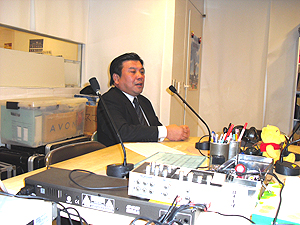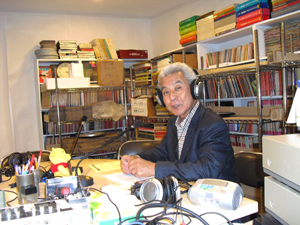Co-operation and strong bonds within the community are more important. If these exist, people will be able to overcome any disaster.
Kobe Municipal Nagata Junior High School Principle: Shigeo Nakamizo
Mr. Nakamizo was a teacher at the local Takatori Junior High School when the earthquake happened and took care of victims who took shelter in the school.
Teachers are quite busy throughout the year, but junior high school teachers are particularly busy in December because they have to help 3rd year students choose their future. When the earthquake happened I was nearing the end of my eleventh year at Takatori Junior High. The maximum number of years a teacher can work at the same junior high school in Kobe is 11 years, but because of the earthquake, I worked there for 12 years. In my final year I didn’t have my own class, I was responsible for school affairs management, including working with the PTA and community.
Although we didn’t know for sure the exact number of people who first took shelter in the school, on the third day after the earthquake a count was made and there were about 2,500 people. There were probably more than 3,000 on the second day. It was probably the largest number in any school shelter. During the first two days or so we really had no idea of how much aid was coming to the school or how it was being distributed, piles of bread and blankets were brought to the gym and were gone before we knew it. We realized this couldn’t continue.
On the third day, Hokuriku Denryoku (electric supply company) set up a generator and we had electricity, and decided we needed some organization and to reduce and limit the numbers in the school.We went around with a hand mike and announced that everyone would be put into groups and divided into rooms and a representative would have to supply a name list of the group so we would be able to distribute aid the next day to each room according to the name list. We asked the representatives. Some groups had up to 50 people in classrooms and in the gym there were about 400 to 500 people, so it was divided into 4 sections. Then there were people in corridors and in the school ground.
The following day, neighbors came to the school looking for food supplies, etc. The whole area around the school was destroyed in fires. Another thing we found out was that most of the people sheltering in the school were from outside the school zone. Most of them were from Nagata. I had been in the school for 11 years, so I knew many of the neighbors. Takatori Junior High School became an aid center in much the same way as Takatori Church.
At first teachers, students and former students worked in the school.
The students did one of the most unpleasant jobs; cleaning the toilets. They were overflowing for the first two or three days. To flush the toilets we had to get bucketfuls of water from the fish pond and later the school swimming pool. On the third day, a large number of temporary toilets arrived.
We tend to think it is the good students who are best on occasions like this, but some of the problem students worked very hard as volunteers right up to the summer holidays. Even students who had refused to come to school worked as volunteers at the school. Actually, the year before the earthquake, Takatori students had created a volunteer committee which did some community clean-up and environmental work. We feel that this helped the students to move smoothly into doing volunteer work after the earthquake.
There were so many people sheltering at the school. We thought they would have formed some organization themselves to look after things, like the distribution of aid. But because of the numbers and there beings so many different kinds of people, nobody could be found who could work as coordinators. In the end, that role had to be taken on by a number of teachers. We did our best cooperating with some people from the community and people from the Takatori Church and its aid center.
Things were still though for at least two months, probably until the school’s graduation ceremony.
Talk 2
Classes resumed in February in the cafeteria of Suma Aqualife Park which had been closed. 3rd grade had their classes in the morning and 1st and 2nd in the afternoon, or something like that. Then in March we had the graduation ceremony. We had no idea where to hold it. Then some people sheltering in the school gym said they would move out so the students could have their graduation ceremony which they deserved. But that meant 300 people and their belongings moving to some of the vacant classrooms in the school. Teachers from other schools, students, parents etc, came to help out. People sheltering in the school collected donations and had telephone cards made for the graduating students. The ceremony and lead up to it was a moving experience. I felt that what we had done in the previous one or two months had all been worthwhile. We had all cooperated to get over that terrible experience. It taught the students many things they would never learn in regular classes. The experience changed the students’ lives and mine, too.
I began to think about what we normally teach in school. Giving students experience is important. Here in Hyogo Prefecture we now have ‘Trial Week’ for junior high students, but before that, at Takatori Junior High, we had work experience for the students. I think we need to be more active in giving opportunities for experience to children. The earthquake, for better or worse, gave them that. Now students, in their comprehensive studies course, get to go out into the community to work with the people there. We need the community’s cooperation and support for this.
I help clean up after the ‘Kobe ni akari wo’ memorial event in Nagata, which is about all I can do because of work commitments, etc. From the beginning, students from local elementary, junior high and recently senior high schools made candles, sang songs, played drums, etc for the event.
Students who graduated from junior high at the time are now 30 years old and those who are 15 were born the year the earthquake happened. Students who are now doing intern work at the Takatori center are 14 years old and so were born after the earthquake. I’d like to get students who were 2nd and 3rd grade at Takatori Junior High at the time to be guest speakers at Nagata Junior High. Takatori Junior High will hold a similar event.People, especially those still in the community, who sheltered in the school also plan a reunion this year. Volunteers who came from all over the country are looking forward to it, too. Bonds made at that time are very strong.
To be prepared for a disaster, having disaster prevention drills etc is important, but I think cooperation and strong bonds within the community are more important. If these exist, people will be able to overcome any disaster.


